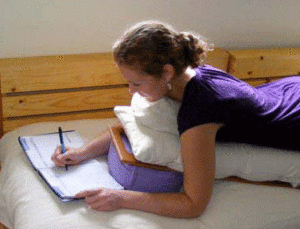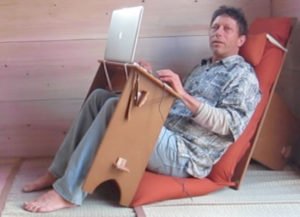The advent of the laptop computer has revolutionized the table-and-desk-sit-down office work station. With the laptop, people are free to lie on the floor or bed, lean back on a couch in the hotel lobby or against a tree, or even stand up. No sooner did an opportunity arise to get rid of sitting in an uncomfortable chair, than did people take advantage of the opportunity. To the trained observer, this proves Dr. Galen Cranz’s hypothesis (author of The Chair) that chairs–even ‘ergonomic’ chairs–are uncomfortable and the body wants to be in another position.
The problem: Ergonomics researchers are unanimous in agreeing the laptop is the worst position for computer use. NO POSITION WORKS! This is best illustrated by this drawing:
1—When placed on a desk or table so as to raise the screen so you can see it (A), the hands/wrists are raised too high, thus leading to carpal tunnel and other problems with shoulders and arms.
2–When used in the primary ‘laptop’ position (B)—on the lap–the user has to stoop to see the screen.
3–When placed on desk/table (C) there is an all-around compromise with neck and arms.
In other words, the laptop is a compromise no matter how you slice it, and mainstream ergonomics warns people to not use it as their primary computer.

The same Eco Backrest™, as above, but this shows the lie down desk position–another unique laptop ergonomic work station..
Lying on the floor in the manner depicted by the media does little to solve the problem, and is only wishful thinking. You’ve got the screen where you can see it, but you’ll kill your neck and shoulders. Maybe you can pay a bill or balance your checkbook, but other than that it is a deceptive image.
A docking station will solve the problem. This is where you use you’re laptop as your hard drive only, and connect it to a separate screen, keyboard and mouse. You place each of these externals in the most suitable ergonomic position: middle of screen at eye level, keyboard and mouse about waist high. Now you are sitting at what mainstream ergonomic would say is as good as it gets, especially if you have an ‘ergonomic’ chair.
However, even these experts will agree the computer work station has problems of it’s own. Rolfer’s, Chiropractors, Massage Therapists, and Yoga Instructors will attest to this. The human body tends to be shaped by the activities performed, and the computer work station keeps them in business. Even the best mainstream workstation pushes the user into a slump, hampers breathing, circulation, and is the main cause of America’s $4 billion back pain epidemic.
I think of my office–and my home–as something like a gymnasium/yoga studio/playground. This new way of doing things can make the most boring work palatable, and can make other work fun, stimulating, inspiring and more productive.

Resting the back completely with the EcoBackrest™.
So ingrained in our culture is sitting that to suggest otherwise is practically heretical. First off, most people have never heard of the idea that chairs are bad for you. It is such a shock to hear this that the usual reaction is disbelief and defensiveness. “You mean everything around me is wrong?” Second, people wouldn’t know where to start to change if they wanted to. Because of this it is best to make small changes in one’s personal life and personal spaces. Since many more of us are practicing ‘telecommuting’ from our home offices, there couldn’t be a better opportunity for making these changes.
The Dynamic Office™ and Body Friendly Furniture™ a complete line of furniture and props that allows one to work in at least four positions:
1–Dynamic Sitting (also called ‘active sitting’)
2–Lying down
3–Lounge position
4–Standing position
Within each of these positions there is much room for movement and variations of positions.
1–“Active sitting”
 is used by physical therapists for patients with coordination/ concentration issues and hyperactivity. If it works for special needs people it must work for other people too, to enhance clarity of thinking and attention span. It has been found that engaging the body in the sitting process like this enhances learning comprehension and retention. Have you ever noticed how you have a lot of your best inspirations while walking or in the shower? The same principle applies here. When the body is engaged in some form of movement the brain is activated. This is also called sensory awareness. This is what causes active sitting or other movement to stimulate the brain. And another factor is, this position lets more oxygen into the lungs which in turn increases brain power.
is used by physical therapists for patients with coordination/ concentration issues and hyperactivity. If it works for special needs people it must work for other people too, to enhance clarity of thinking and attention span. It has been found that engaging the body in the sitting process like this enhances learning comprehension and retention. Have you ever noticed how you have a lot of your best inspirations while walking or in the shower? The same principle applies here. When the body is engaged in some form of movement the brain is activated. This is also called sensory awareness. This is what causes active sitting or other movement to stimulate the brain. And another factor is, this position lets more oxygen into the lungs which in turn increases brain power.
For this sitting process to work at a laptop or standard computer work station, the computer or desk must be at the right height and angle so the neck is not bent too far looking down. This is usually somewhat higher than an average desk, because the seat is usually higher. Actually, a drafting table can be the perfect work surface, as long as you have a way to stabalize your laptop from sliding downward. A small piece of a yoga sticky mat seems to do just the trick (available from Carolina Morning Designs). One can sit on any of the varieties of saddle seats, ball chairs and kneeling chairs on the market, including our own Tilt Seat™.
Before we had to worry about laptop ergonomics,
2–Standing Position:
Thomas Jefferson is known for his stand up desk, and German students traditionally stood at podiums in the classroom. However, standing isn’t for everyone. It burns calories and tones muscles at a gradual pace which is safe and effective. It is for the office warrior who wants the maximum fitness from an otherwise sedentary job.
 The keyboard is out of sight because it is so far from the screen. The challenge is touch typing when the keyboard is completely out of view. This takes some getting used to but gets easy with practice.
The keyboard is out of sight because it is so far from the screen. The challenge is touch typing when the keyboard is completely out of view. This takes some getting used to but gets easy with practice.
3—Lying Face Down
This is the position I blasted earlier for its poor ergonomics. However, we have a prop that solves the problems and makes it the most restorative and relaxing of all other positions. Our Eco Backrest™ solves the problem and many people have been jumping for joy since they discovered this. You have to try it to believe how amazing it is. The line of sight is perfect so there is no bending of the neck to see the screen. See illustration.
4—Lounge
This is what we try for when sitting in bed propped against the headboard or putting a bunch of throw pillows together. However that doesn’t work because the back and neck are crunched. What is needed is the ‘spine neutral’ effect—like being in an airplane cockpit or spaceship. Now with the Eco Backrest™–no more worries.
One of these positions alone will not do what they all do synergistically. Sometimes we need to wake up, so standing works best. Sometimes we are tired so lying down or lounging works best. The point is, no longer is the office seen as a static thing. In the Dynamic Office™, the furniture is designed around the human body, not the other way around.
